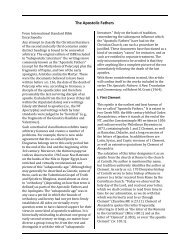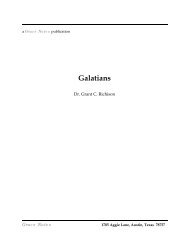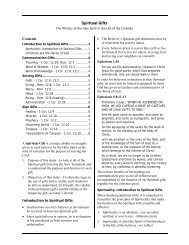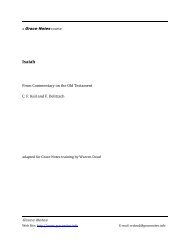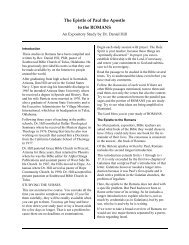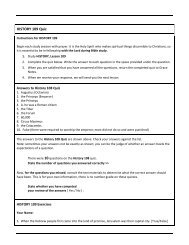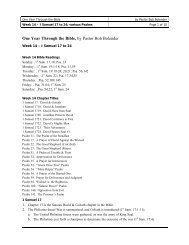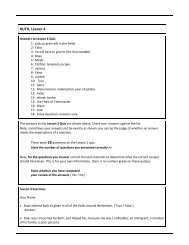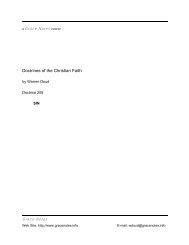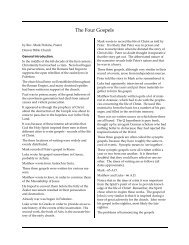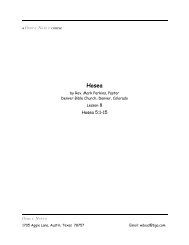Song of Solomon - Grace Notes
Song of Solomon - Grace Notes
Song of Solomon - Grace Notes
You also want an ePaper? Increase the reach of your titles
YUMPU automatically turns print PDFs into web optimized ePapers that Google loves.
SONG OF SOLOMON Page 23By C. F. Keil and F. Delitzscha <strong>Grace</strong> <strong>Notes</strong> studyethically: to delight in something particularly,to take pleasure in intercourse with one, isרֵ עֶּ ה the mas. is ;נַעֲ רָ ה formed in the same way as(= ra’j), abbreviated עַ ,רֵ whence the fem. ră’yāh(Judg. 11:37; Chethîb), as well as rē’āh, also withreference to the ground-form. At once, in thefirst words used by <strong>Solomon</strong>, one recognises aPhilip, i.e., a man fond <strong>of</strong> horses,—an importantfeature in the character <strong>of</strong> the sage (vid., Sur. 38<strong>of</strong> the Koran),—and that, one fond <strong>of</strong> Egyptianhorses: <strong>Solomon</strong> carried on an extensiveimportation <strong>of</strong> horses from Egypt and othercountries (2 Chron. 9:28); he possessed 1400war-chariots and 12,000 horsemen (1 Kings10:26); the number <strong>of</strong> stalls <strong>of</strong> horses for hischariots was still greater (1 Kings 5:6) [4:26].Horace (Ode iii. 11) compares a young sprightlymaiden to a nimble and timid equa trima;Anacreon (60) addresses such an one: “thouThracian filly;” and Theocritus says (Idyl xviii.30, 31):“As towers the cypress mid the garden’sbloom,As in the chariot proud Thessalian steed,Thus graceful rose-complexioned Helenmoves.”But how it could occur to the author <strong>of</strong> the <strong>Song</strong>to begin the praise <strong>of</strong> the beauty <strong>of</strong> ashepherdess by saying that she is like a horse inPharaoh’s chariot, is explained only by thesupposition that the poet is <strong>Solomon</strong>, who, as akeen hippologue, had an open eye for thebeauty <strong>of</strong> the horse. Egyptian horses were thenesteemed as afterwards the Arabian were.Moreover, the horse was not native to Egypt,but was probably first imported thither by theHyksos: the Egyptian name <strong>of</strong> the horse, andparticularly <strong>of</strong> the mare, ses-t, ses-mut, and <strong>of</strong>the chariot, markabuta, are Semitic. סּוסָ ה is herenot equitatus (Jerome), as Hengst. maintains:“Susah does not denote a horse, but is usedcollectively;” while he adds, “Shulamith iscompared to the whole Egyptian cavalry, and istherefore an ideal person.” The formerstatement is untrue, and the latter is absurd.Sūs means equus, and susā may, indeed,collectively denote the stud (cf. Josh. 19:5 with1 Chron. 4:31), but obviously it first denotes theequa. But is it to be rendered, with the LXX andthe Venet., “to my horse”? Certainly not; for thechariots <strong>of</strong> Pharaoh are just the chariots <strong>of</strong>Egypt, not <strong>of</strong> the king <strong>of</strong> Israel. The Chirek inwhich this word terminates is the Ch. compag.,which also frequently occurs where, as hereand Gen. 49:11, the second member <strong>of</strong> theword-chain is furnished with a prep. (vid.,under Ps. 113). This i is an old genitival ending,which, as such, has disappeared from thelanguage; it is almost always accented as thesuff. Thus also here, where the Metheg shows,רִ כְׁ בֵ י plur. that the accent rests on the ult. Theoccurring only here, is the amplificative poetic,and denotes state equipage. דִ ֹּמָ ה is the trans. <strong>of</strong>which combines the meanings aequum and ,דָ מָ הaequalem esse. Although not allegorizing, yet,that we may not overlook the judiciousness <strong>of</strong>the comparison, we must remark thatShulamith is certainly a “daughter <strong>of</strong> Israel;” adaughter <strong>of</strong> the people who increased in Egypt,and, set free from the bondage <strong>of</strong> Pharaoh,became the bride <strong>of</strong> Jahve, and were brought bythe law as a covenant into a marriage relationto Him.The transition to v. 10 is mediated by the effect<strong>of</strong> the comparison; for the head-frame <strong>of</strong> thehorse’s bridle, and the poitral, were thencertainly, must as now, adorned with silkentassels, fringes, and other ornaments <strong>of</strong> silver(vid., Lane’s Modern Egypt, I 149). Jerome,absurdly, after the LXX: pulchrae sunt genae,ּתֹר turtle, tuae sicut turturis. The name <strong>of</strong> theredupl. turtur, is a pure onomatopoeia, whichhas nothing to do with ,ּתּור whence ,דּור to goround about, or to move in a circle; and turtledove’scheeks—what absurdity! Birds have nocheeks; and on the sides <strong>of</strong> its neck the turtledovehas black and white variegated feathers,which also furnishes no comparison for thecolour <strong>of</strong> the cheeks. ּתורִ ים are the roundornaments which hang down in front on bothsides <strong>of</strong> the head-band, or are also inwoven in



